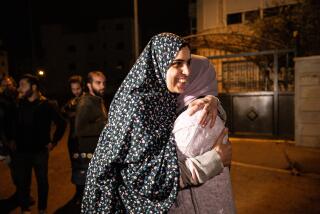Lebanon Army Takes Last PLO Positions in Sidon Area
SIDON, Lebanon — The victorious Lebanese army occupied the last PLO positions in southern Lebanon on Friday, advancing to the edge of Palestinian refugee camps and ending 20 years of PLO gun rule in the area.
After four days of fighting, the Palestine Liberation Organization agreed Thursday to restrict its fighters to the Ein el Hilwa and Miye ou Miye camps near Sidon, 25 miles south of Beirut, and to move their heavy weapons out of the country.
Army officials in Sidon said the weapons to be handed over include antiaircraft guns, mortars, cannons and rocket-propelled grenade launchers.
The accord between the PLO and the government leaves the 5,000 Palestinian guerrillas equipped only with automatic rifles.
The accord means an easing of the army’s four-day siege of the refugee camps. On Friday, trucks loaded with vegetables, meat and other food drove past army checkpoints to the camps, where about 60,000 Palestinian refugees live.
Hospital sources said that 73 people were killed and 200 wounded in battles for control of the positions. Most of the dead and wounded were Palestinians.
The guerrillas’ withdrawal to the refugee camps places the Lebanese army across infiltration routes used by the fighters to attack Israel and its allies.
From his headquarters in Tunisia, PLO Chairman Yasser Arafat declared full backing for the accord. The agreement is an important step in the Lebanese government’s attempt to assert control over southern Lebanon after 16 years of civil war.
Hundreds of commandos first secured a road into Miye ou Miye village, next to the refugee camp on Sidon’s eastern edge. They then fanned out to take other routes.
“It was like hell on Earth. The shells and sniper bullets were like rain,” said Hanna Hamkir, 55, who with her three children were among the few civilians who stayed in the village during the fighting.
The soldiers, heavily armed and wearing red berets, were followed by tanks and armored personnel carriers, driving past shell craters, burned out PLO vehicles and shell-pocked homes.
The move was a massive blow to the PLO, expelled from Beirut in 1982 by Israeli troops and from north Lebanon a year later by the Syrian army.
The Syrian-backed government, moving to extend state control through all of Lebanon, wants to block guerrilla raids on Israeli forces in the hope that Washington will urge Israel to withdraw from its self-declared buffer zone.
As the troops fanned out, hundreds of Palestinian refugees streamed back to the two camps.
Hundreds of refugees and PLO guerrillas, looking angry and dejected, watched from inside the camps as soldiers took up their positions. Other refugees buried the dead.
“This conspiracy is to make us pay the price for our stand in the Gulf (War) against America, Saudi Arabia and all the Arabs,” said a 23-year-old guerrilla wounded in the head.
Palestinians in the Israeli-occupied West Bank also reacted with disappointment to the accord. “I only see darkness. . . . There is no light at the end of the tunnel,” said Saeed Kanaan, a West Bank businessman known to support the PLO’s mainstream Fatah faction.
Palestinian sources said the PLO would present a list of its demands to the government and talks would start soon after the peace plan for the Sidon area is put in place.
More to Read
Sign up for Essential California
The most important California stories and recommendations in your inbox every morning.
You may occasionally receive promotional content from the Los Angeles Times.










